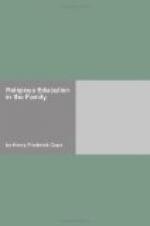4. The exploring party.—But even after the walk it will not be long before the little ones are asking, “What can we do next?” So we organize the exploring party. Our object is to discover the countries, scenes, strange peoples, and most interesting persons we have heard of in the Bible. We are to find them in the advertising sections of old magazines. Let each one take a magazine and go through it, looking for oriental scenes, for pictures of incidents and of men and women that will remind him of Bible scenes and characters. These are to be cut out, explained, and arranged in the order of time, as they happened, every member of the family helping. The same plan may be applied to scenes of missionary work, using blank books for stories of heroism which children will illustrate with the magazine pictures.
5. Home thoughts.—“Home, sweet home,” is just a corner of the afternoon saved for the discovery and reading of selections that are worth keeping in our memories and are also likely to help us hold our homes in some measure of the love and reverence they deserve. There are songs of home that ought never to be forgotten.
6. Religious reading and songs close the day happily.—Children love religious reading and songs, provided they are offered for their worth and not as an exercise, or to be learned as an empty duty. Take down your Bible and read Psalm 100, “Make a joyful noise unto the Lord, all ye lands”; see whether they do not all enjoy the music and majesty of those lines. You will not find it difficult to secure their co-operation in learning that by heart.
Then close the day with an hour of song. The children will remember songs learned thus all their lives; therefore those worth remembering should be chosen. For one, there is that dear old song many of us learned at mother’s knee, “Jesus loves me, this I know.” That and others that are appropriate can be found in almost every hymnbook. Many books of school songs also have a few hymns and Sunday songs that children like.
Parents are puzzled, perhaps most of all, to choose appropriate stories to read to the children on Sunday. Youngsters prefer, of course, the told story to the read one, but if you wish to read you will make no mistake in selecting Christie’s Old Organ; Aunt Abbey’s Neighbors, by Annie T. Slosson; The Book of Golden Deeds, by Charlotte M. Yonge; and Telling Bible Stories, by Louise S. Houghton. Some Great Stories and How to Tell Them, by Richard Wyche, and Story Telling, by Edna Lyman, will serve as good guides to what to tell, and how to tell it.
7. Naming the day.—From week to week variety should enter into the Sunday program. On the Sunday following the one described above we can begin at the dinner table the happy task of “naming the day.” We can decide whether it shall be called after one of our own number, whose birthday falls near this date, or after one of the anniversaries of the week following.




